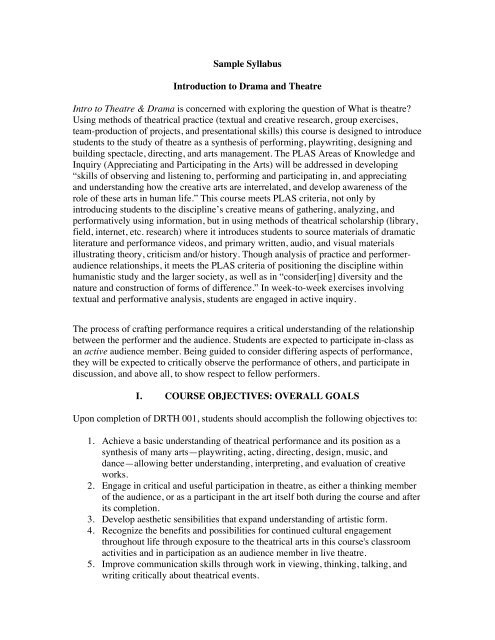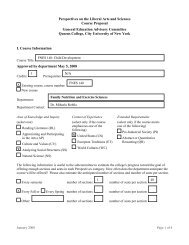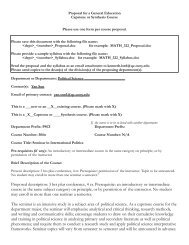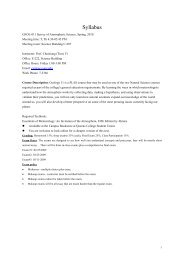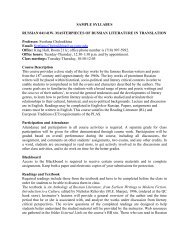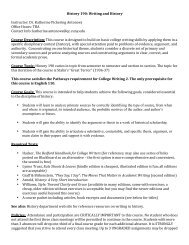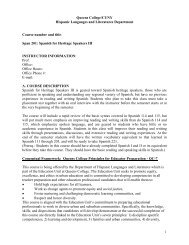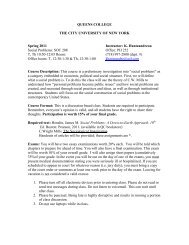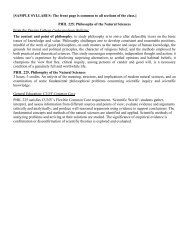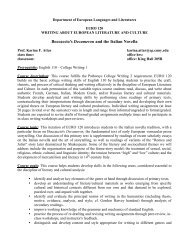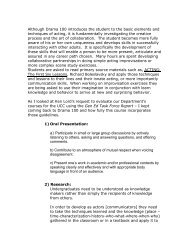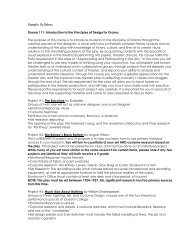Sample Syllabus Introduction to Drama and Theatre Intro to Theatre ...
Sample Syllabus Introduction to Drama and Theatre Intro to Theatre ...
Sample Syllabus Introduction to Drama and Theatre Intro to Theatre ...
You also want an ePaper? Increase the reach of your titles
YUMPU automatically turns print PDFs into web optimized ePapers that Google loves.
<strong>Sample</strong> <strong>Syllabus</strong><br />
<strong><strong>Intro</strong>duction</strong> <strong>to</strong> <strong>Drama</strong> <strong>and</strong> <strong>Theatre</strong><br />
<strong>Intro</strong> <strong>to</strong> <strong>Theatre</strong> & <strong>Drama</strong> is concerned with exploring the question of What is theatre?<br />
Using methods of theatrical practice (textual <strong>and</strong> creative research, group exercises,<br />
team-production of projects, <strong>and</strong> presentational skills) this course is designed <strong>to</strong> introduce<br />
students <strong>to</strong> the study of theatre as a synthesis of performing, playwriting, designing <strong>and</strong><br />
building spectacle, directing, <strong>and</strong> arts management. The PLAS Areas of Knowledge <strong>and</strong><br />
Inquiry (Appreciating <strong>and</strong> Participating in the Arts) will be addressed in developing<br />
“skills of observing <strong>and</strong> listening <strong>to</strong>, performing <strong>and</strong> participating in, <strong>and</strong> appreciating<br />
<strong>and</strong> underst<strong>and</strong>ing how the creative arts are interrelated, <strong>and</strong> develop awareness of the<br />
role of these arts in human life.” This course meets PLAS criteria, not only by<br />
introducing students <strong>to</strong> the discipline’s creative means of gathering, analyzing, <strong>and</strong><br />
performatively using information, but in using methods of theatrical scholarship (library,<br />
field, internet, etc. research) where it introduces students <strong>to</strong> source materials of dramatic<br />
literature <strong>and</strong> performance videos, <strong>and</strong> primary written, audio, <strong>and</strong> visual materials<br />
illustrating theory, criticism <strong>and</strong>/or his<strong>to</strong>ry. Though analysis of practice <strong>and</strong> performeraudience<br />
relationships, it meets the PLAS criteria of positioning the discipline within<br />
humanistic study <strong>and</strong> the larger society, as well as in “consider[ing] diversity <strong>and</strong> the<br />
nature <strong>and</strong> construction of forms of difference.” In week-<strong>to</strong>-week exercises involving<br />
textual <strong>and</strong> performative analysis, students are engaged in active inquiry.<br />
The process of crafting performance requires a critical underst<strong>and</strong>ing of the relationship<br />
between the performer <strong>and</strong> the audience. Students are expected <strong>to</strong> participate in-class as<br />
an active audience member. Being guided <strong>to</strong> consider differing aspects of performance,<br />
they will be expected <strong>to</strong> critically observe the performance of others, <strong>and</strong> participate in<br />
discussion, <strong>and</strong> above all, <strong>to</strong> show respect <strong>to</strong> fellow performers.<br />
I. COURSE OBJECTIVES: OVERALL GOALS<br />
Upon completion of DRTH 001, students should accomplish the following objectives <strong>to</strong>:<br />
1. Achieve a basic underst<strong>and</strong>ing of theatrical performance <strong>and</strong> its position as a<br />
synthesis of many arts—playwriting, acting, directing, design, music, <strong>and</strong><br />
dance—allowing better underst<strong>and</strong>ing, interpreting, <strong>and</strong> evaluation of creative<br />
works.<br />
2. Engage in critical <strong>and</strong> useful participation in theatre, as either a thinking member<br />
of the audience, or as a participant in the art itself both during the course <strong>and</strong> after<br />
its completion.<br />
3. Develop aesthetic sensibilities that exp<strong>and</strong> underst<strong>and</strong>ing of artistic form.<br />
4. Recognize the benefits <strong>and</strong> possibilities for continued cultural engagement<br />
throughout life through exposure <strong>to</strong> the theatrical arts in this course's classroom<br />
activities <strong>and</strong> in participation as an audience member in live theatre.<br />
5. Improve communication skills through work in viewing, thinking, talking, <strong>and</strong><br />
writing critically about theatrical events.
6. Increase sensitivity <strong>to</strong> the values of others through exposure <strong>to</strong> diverse opinions in<br />
both the drama <strong>and</strong> its performance <strong>and</strong> in class discussions on those issues.<br />
7. Develop skills in problem solving through analysis of, discussions about, <strong>and</strong><br />
group projects on theatrical texts <strong>and</strong> performances.<br />
8. Develop skills <strong>to</strong> cooperatively work in groups through efforts in group projects<br />
<strong>and</strong> discussions, <strong>and</strong> participation in the social <strong>and</strong> collaborative experience of<br />
live theatre.<br />
9. Examine personal interests, talents, <strong>and</strong> goals through exposure <strong>to</strong> <strong>and</strong><br />
participation in the wide range of experiences inherent in theatrical presentation.<br />
II. COURSE CONTENT AND FORMAT:<br />
In addition <strong>to</strong> our weekly 3-hr long classes, students are required 3 hours in shop<br />
activities [costumes, sets, lights, etc]; hours <strong>to</strong> fulfill this requirement will be selected by<br />
the student from a range of timeslots. 3 hours credit<br />
A. Required Attendance at Departmental Production<br />
Students will be required <strong>to</strong> attend 1 or 2 departmental productions <strong>and</strong> write a critique<br />
as guided.<br />
Course Grades<br />
B. Course Policies <strong>and</strong> Procedures:<br />
Attendance:<br />
Presence is essential in order <strong>to</strong> earn in-class participation points. Absences need <strong>to</strong> be<br />
supported by medical, university, etc. documentation. NOTE: Should extended illness or<br />
other personal crises compel you <strong>to</strong> have excessive absences, you are advised <strong>to</strong> drop the<br />
course since in-class participation in group exercises <strong>and</strong> discussions is 50% of your<br />
final grade.<br />
Arriving late for class or leaving early, hurts your participation points. Just because<br />
you are present at a class, does not insure a high mark for participation; your participation<br />
points are earned based on how well you participate in the in-class exercises as evaluated<br />
by your instruc<strong>to</strong>r.<br />
Writing:<br />
Everyone must complete a critique on each of the productions that will be seen by the<br />
class.<br />
This assignment, though short, will require careful organization <strong>and</strong> clear analysis.<br />
Shop Hours: Students will be required <strong>to</strong> sign-up in the shop (first-come-first-servebasis)<br />
<strong>to</strong> work on a production crew (painting, carpentry, lights, sounds, costuming, etc)<br />
for a three-hour block of time. A minimum of three-hours of additional shop work earns<br />
2 extra credit points.
Final:<br />
A final paper <strong>and</strong>/or project will be required; the <strong>to</strong>pic(s) will be provided by the<br />
instruc<strong>to</strong>r at midterm. Final papers must be h<strong>and</strong>ed over in person during the class<br />
meeting in finals week.<br />
Grading: All grading will be based on the number of points you earn. There is no curve.<br />
The maximum amount of points which can be earned:<br />
Extra Credit shop hours (at least 3 extra<br />
hours)<br />
- 2<br />
In-class participation - 50<br />
Critique - 10<br />
Shop hours 10<br />
Final project<br />
Final creative paper<br />
- 20<br />
10<br />
Total Possible points - 102<br />
Unannounced tests may be given at any time at the instruc<strong>to</strong>r’s prerogative. Since any<br />
assigned research or readings are meant <strong>to</strong> help you prepare for the work we will be<br />
doing in class, they will not be accepted late. The critique <strong>and</strong> the final exam will be<br />
accepted late only with formal documentation of an emergency. Late arrivals/returns from<br />
break <strong>and</strong> early departures will result in lower participation points unless you can provide<br />
formal documentation of the emergency that calls you away. In this class, you are often<br />
involved in teamwork—part of your responsibility <strong>to</strong> your team is <strong>to</strong> be present <strong>and</strong><br />
prepared; this will be reflected in your final grade. Anything that detracts you from your<br />
responsibility <strong>to</strong> participate actively as a team member (cellphones, pagers, etc) must be<br />
turned off <strong>and</strong> not accessed except when you are on a class break.<br />
Date Topic<br />
Class 1 <strong>Intro</strong> <strong>to</strong> course <strong>and</strong> methods of inquiry<br />
Class 2 The Nature of Art<br />
Exercises <strong>and</strong> discussion <strong>to</strong> examine the place of theatrical form within<br />
artistic form in general<br />
Class 3 The <strong>Theatre</strong> as a Fine Art<br />
Exercises <strong>and</strong> discussion of formal elements of theatre as experienced in<br />
dramatic <strong>and</strong> performative texts<br />
Class 4 Acting<br />
Exercises in concentration, observation, sense memory <strong>and</strong> awareness,<br />
<strong>and</strong> characterization<br />
Class 5 Acting<br />
Continuation of practical explorations from prior class leading <strong>to</strong><br />
discussion of theoretical implications, <strong>and</strong> introduction <strong>to</strong> more highly<br />
stylized forms of acting<br />
Class 6 Directing<br />
<strong><strong>Intro</strong>duction</strong> <strong>to</strong> stage terminology, direc<strong>to</strong>rial focus, <strong>and</strong> exercises in
team-work as a means of inquiry leading <strong>to</strong> the crafting of performances<br />
Class 7 Directing<br />
Continuation of practical exercises <strong>and</strong> discussions from prior class.<br />
Discussion of direc<strong>to</strong>r’s role in the contemporary field <strong>and</strong> through<br />
his<strong>to</strong>ry<br />
Class 8 Designers<br />
Exercises <strong>and</strong> discussions exploring the use of line, shape/silhouette,<br />
rhythm, color, sound/silence, <strong>and</strong> texture as elements of theatrical design;<br />
consideration of the differing uses <strong>and</strong> influences of design in theatre as<br />
opposed <strong>to</strong> the use of these elements in other art forms<br />
Class 9 Criticism<br />
Analysis of various modes of theatrical criticism; discussion of critic’s<br />
role in the field of theatre. Critique of live performance due (Playboy of<br />
the Western World).<br />
Class 10 Arts management<br />
Exercises <strong>and</strong> discussions exploring the work of stage managers, house<br />
managers, <strong>and</strong> general arts management structures<br />
Class 11 Audience<br />
Exercises <strong>and</strong> discussions exploring spatial configurations of stages <strong>and</strong><br />
venues <strong>and</strong> their influences on both the performer’s presentation <strong>and</strong> the<br />
audiences’ perception of the event<br />
Class 12 Playwriting<br />
Analysis of dramatic structure of a drama: (read Lysistrata <strong>and</strong> prepare<br />
assigned dramaturgical research on Attic theatre). Discussion of<br />
‘moving from the-page-<strong>to</strong>-the-stage.’<br />
Class 13 <strong>Theatre</strong> Scholarship/Western Thr His<strong>to</strong>ry<br />
Assigned research on Greek, Roman, Shakespearean, <strong>and</strong> Stanislavskian<br />
contributions <strong>to</strong> theatrical his<strong>to</strong>ry.<br />
Class 14 <strong>Theatre</strong> Scholarship/Non-Western Thr His<strong>to</strong>ry<br />
Assigned research on Chinese, Japanese, American Indian, <strong>and</strong> African<br />
Finals week<br />
meeting:<br />
<strong>Sample</strong> pop quiz<br />
<strong>Intro</strong> <strong>to</strong> <strong>Theatre</strong><br />
contributions <strong>to</strong> theatrical his<strong>to</strong>ry<br />
Final Exam (creative analysis paper <strong>and</strong> group project<br />
presentations)<br />
1-4. Name four of the five fields of design: ---------------------------------------------------, ------------------------------------------<br />
-------------------------------------------------------------------------------------------------------------, --------------------------------------------------------------------------<br />
----------------------------<br />
5. If an ac<strong>to</strong>r is at the X on the stage, we say that he/she is at ------------------------------------------------<br />
(name of stage position).
6-7. In theatre configurations (shapes of spaces); a space with audience on three sides is<br />
called -------------------------------<strong>and</strong> a space with the audience on four sides is called -------------------------------<br />
----------------------------------------<br />
8. Name the kind of theatre configuration found in Goldstein theatre: ----------------------------------------<br />
------------------------------------<br />
9-16. Match the positions in column 1 with the functions\qualities in column 2 (each<br />
position in column 1 may have from 1-3 answers from column 2; do not use an answer<br />
from column 2 more than once):<br />
ac<strong>to</strong>r ------- -------- --------<br />
critic------- -------- --------<br />
producer------- -------- --------<br />
set designer------- -------- -------<br />
a. describes audience response<br />
b. has an immediate interaction with an<br />
audience<br />
c. focuses on physical <strong>and</strong> vocal aspects<br />
d. concerned with color <strong>and</strong> line<br />
e. does not have a vested interest in the<br />
show’s success<br />
f. in overall charge of financial matters<br />
g. develops a high degree of concentration<br />
h. most likely <strong>to</strong> locate a theatre venue for the<br />
show<br />
17-19. An ac<strong>to</strong>r has three foci (focuses): he/she may direct attention <strong>to</strong> --------------------------------------<br />
-------------, <strong>to</strong> -----------------------------------------------------------------------------------------------------------------, or <strong>to</strong> ------------------------------<br />
----------------------------------------------------.<br />
20-21. Two forms of playwriting structures that we worked with in class are -------------------------<br />
------------------------------- & --------------------------------------------------.<br />
22. Name one Asian theatre form that uses little, if any, scenery: -------------------------------------------------<br />
----------------.<br />
23-26. One of the elements of design that a designer works with <strong>to</strong> create mood is line:<br />
name four others:<br />
----------------------------------------, ----------------------------------------, ----------------------------------------, <strong>and</strong> ---------------------------------<br />
-------------------.<br />
27-28. What do we call the person who is in charge of the scene shop? --------------------------------<br />
----, <strong>and</strong> what do we call the person who is in charge of blocking the ac<strong>to</strong>rs? -------------------------------<br />
------------------------------------------------------.
(Using only one or two sentences per question, answer 29 & 30 on the back of your test<br />
paper)<br />
29. From your viewing of The Playboy of the Western World, describe how one of the<br />
scenic elements (lights, set, costumes) helped <strong>to</strong> set the mood.<br />
30. From your viewing of The Playboy of the Western World,, give an example of how an<br />
ac<strong>to</strong>r used a physical action (pose, gesture, etc) <strong>to</strong> help suggest their character.


